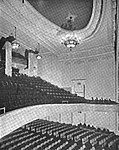Strand Theatre (Manhattan)
1987 establishments in New York CityBroadway (Manhattan)Buildings and structures demolished in 1987Cinemas and movie theaters in ManhattanDemolished theatres in New York City ... and 4 more
Former theatres in ManhattanMovie palacesThomas W. Lamb buildingsTimes Square buildings

The Strand Theatre was an early movie palace located at 1579 Broadway, at the northwest corner of 47th Street and Broadway in Times Square, New York City. Opened in 1914, the theater was later known as the Mark Strand Theatre, the Warner Theatre, and the Cinerama Theatre. It closed as the RKO Warner Twin Theatre, and was demolished in 1987.
Excerpt from the Wikipedia article Strand Theatre (Manhattan) (License: CC BY-SA 3.0, Authors, Images).Strand Theatre (Manhattan)
Broadway, New York Manhattan
Geographical coordinates (GPS) Address Nearby Places Show on map
Geographical coordinates (GPS)
| Latitude | Longitude |
|---|---|
| N 40.759669444444 ° | E -73.985266666667 ° |
Address
Morgan Stanley Building (1585 Broadway)
Broadway 1585
10019 New York, Manhattan
New York, United States
Open on Google Maps









